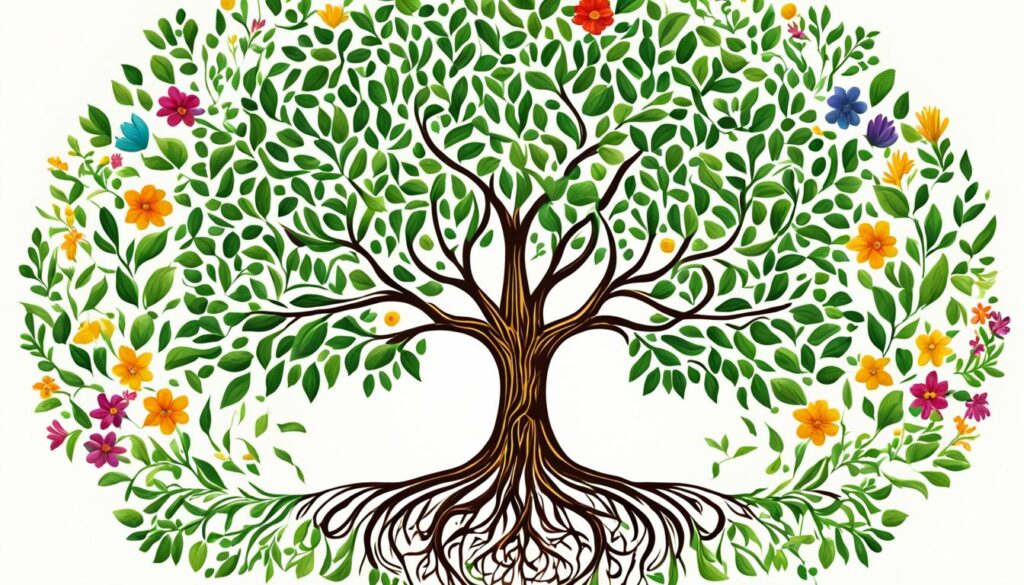In today’s fast-paced world, household dynamics can be challenging. The relationships between family members can be complex and demanding, requiring a balance between individuality and togetherness. At the same time, it’s essential to foster a sense of harmony and growth within the household, to ensure that each member feels valued and supported.
This article will explore various strategies and tips for navigating family dynamics, highlighting the importance of effective communication, trust-building, conflict resolution, emotional well-being, values instillation, and maintaining strong connections with extended family members. By embracing these tactics, individuals and families can cultivate a harmonious and supportive environment that fosters growth and deeper relationships with one another.
Key Takeaways:
- Effective communication and trust-building are crucial for building strong foundations in a family.
- Conflict management and resolution strategies can help to prevent disagreements from escalating.
- Nurturing emotional well-being among family members is essential for a harmonious and supportive environment.
- Instilling family values and maintaining traditions can strengthen bonds and foster a deep sense of connection amongst family members.
- Striking a balance between individuality and togetherness is crucial for healthy family dynamics.
Understanding Family Dynamics
Family dynamics refer to the patterns of interaction and relationships among family members. Understanding these dynamics is crucial in promoting harmony and growth within the household. Family dynamics can be complex and varied, influenced by factors such as culture, gender roles, and individual personalities.
Types of Family Structures
Family structures can differ based on various factors, including size, living arrangements, and relationship dynamics. Common types of family structures include:
| Family Structure | Description |
|---|---|
| Nuclear Family | A family unit consisting of parents and their biological or adopted children. |
| Single-Parent Family | A family where one parent raises their children. |
| Blended Family | A family where two separate families merge into one unit, typically resulting from remarriage including step-parents and step-siblings. |
| Extended Family | A family that includes grandparents, aunts, uncles, and cousins, in addition to parents and siblings. |
Each family structure comes with its own unique challenges and dynamics that can impact relationships and communication.
Influence of Family Dynamics on Relationships
Family dynamics play a significant role in shaping relationships between family members. Positive dynamics can promote trust, open communication, and a sense of belonging, while negative dynamics can lead to conflicts and strained relationships.
The understanding of family dynamics can help family members in framing their expectations from one another and inculcating healthy practices. Moreover, it contributes to the resolution of conflicts and hastens cooperation amongst them.

Building Strong Foundations: Communication and Trust
Strong family foundations are built on effective communication and trust. By fostering open, honest, and respectful communication within the household, family members can communicate their needs, concerns, and aspirations honestly. In addition, trust plays a crucial role in creating a healthy family dynamic. Trust is established through acts of honesty, reliability, and dependability, where each family member can rely on one another.
To build trust and healthy communication, active listening is key. Each family member should listen empathetically and validate the other’s feelings. By doing so, each member feels heard and acknowledged. Furthermore, each member should respect one another, validating each other’s opinions and concerns. When disagreements arise, constructive dialogue and finding common ground can help manage conflicts and resolve issues.

In summary, building strong foundations within a family is rooted in communication and trust. By fostering an environment of open, honest, and respectful communication, combined with trust, family members can be emotionally secure within the household, and ultimately, lead to a harmonious family dynamic.
Managing Conflict and Resolving Issues
Conflict is an inevitable part of any family dynamic. It is how you manage it that makes the difference. There are various strategies that can be used to effectively manage conflicts and ensure their timely resolutions.
One of the most effective ways of managing conflict is to have constructive dialogue. This involves expressing your feelings and concerns in a respectful manner and actively listening to the other person’s point of view. By doing this, you can find common ground and work towards a mutually beneficial solution.
Active listening is crucial when it comes to resolving conflicts. It involves giving your full attention to the person speaking and making a conscious effort to understand their perspective. Make sure to clarify your understanding by summarizing what the other person has said, which can help prevent any misunderstandings and resolve any issues.
Another important strategy for managing conflict is to find common ground. This involves identifying areas where you both agree and working from there. By focusing on the areas where you have similar ideas, you can build a more positive relationship and work towards a resolution.

«In family relationships, peaceful resolution is always preferred over the escalation of conflicts.»
Nurturing Emotional Well-being
Emotional well-being is a crucial aspect of maintaining a harmonious family environment. Every family member should feel emotionally secure and validated, being able to express themselves openly. The following are some strategies for nurturing emotional well-being:
- Empathy: Show empathy towards each family member’s feelings and perspectives. Try to understand their point of view, even if you don’t agree with it. This will help foster emotional connection and openness.
- Validation: Validate each family member’s emotions and experiences. This means acknowledging their feelings as valid, even if you can’t relate to them. Validation fosters emotional safety and encourages open communication.
- Safe space: Create a safe space for emotional expression. Encourage family members to share their thoughts and feelings without fear of judgment or criticism.
Benefits of nurturing emotional well-being
Nurturing emotional well-being can have several benefits for both individuals and families, including:
| Benefit | Description |
|---|---|
| Improved communication | Open and honest communication is more likely to occur when family members feel emotionally safe and validated. |
| Stronger bonds | Emotional support and validation foster deeper connections between family members, resulting in stronger bonds. |
| Positive conflict resolution | Emotionally secure individuals are better equipped to handle conflicts constructively, focusing on resolution rather than blame or hostility. |
| Lower stress levels | A safe emotional environment reduces stress levels and promotes emotional well-being for each family member. |
Nurturing emotional well-being is a continuous process that requires consistent effort by each family member. By fostering a safe emotional environment and practicing empathy and validation, families can build healthy, positive, and long-lasting relationships.

Instilling Values and Traditions
Instilling values and traditions within a family is crucial for creating a sense of belonging and fostering healthy family dynamics. Shared values are essential for building strong relationships and maintaining harmony within the household. It is also important to maintain and pass down meaningful traditions that hold significance for the family.
Some tips for instilling values and traditions in your family:
- Communicate the importance of values and traditions to your family members.
- Choose values that align with your family’s beliefs and goals.
- Create and participate in traditions that hold meaning for your family.
- Encourage your family members to share their own values and ideas for traditions

“Family traditions counter alienation and confusion. They help us define who we are; they provide something steady, reliable and safe in a confusing world.” — Susan Lieberman
By instilling values and traditions within your family, you are creating a legacy that can be passed down for generations.
Balancing Individuality and Togetherness
The delicate balance of individuality and togetherness is necessary for fostering healthy family relationships. While recognizing and respecting individuality, it’s crucial to maintain a sense of unity and togetherness as a family. This balance is necessary to enable family members to thrive as individuals while maintaining a strong sense of connection with one another.
One way to balance individuality and togetherness is by setting boundaries. Clear communication of individual needs and preferences can help prevent misunderstandings and conflicts. Recognizing and respecting each other’s boundaries can enable family members to be themselves without fear of being judged.
Encouraging independence within a supportive framework is another way to balance individuality and togetherness. Allowing family members to pursue their interests and passions while providing support and encouragement can help develop a sense of self while maintaining a strong family bond.
Overall, finding the right balance between individuality and togetherness requires open communication, mutual respect, and a willingness to compromise. By recognizing and respecting each other’s differences and needs, families can foster a sense of unity and togetherness while honoring individuality.

Parenting Styles and Parent-Child Relationships
Parenting styles can have a significant impact on the parent-child relationship. By understanding different parenting styles, parents can make informed decisions that help build healthy and positive relationships with their children.
Let’s take a closer look at some of the most common parenting styles:
| Parenting Style | Description |
|---|---|
| Authoritarian | Strict rules and high expectations; punishments for not following rules. |
| Permissive | Little to no rules or expectations; children are free to do what they want. |
| Authoritative | Clear rules and expectations, with flexibility for appropriate independence. Consequences for not following rules are explained and reasonable in nature. |
| Uninvolved | Lack of interest and involvement in the child’s life and well-being. |
Note: While these parenting styles are generally recognized in the field of psychology, each family and child is unique. No single approach fits every situation, and many parents use a combination of these styles.
Regardless of the parenting style used, there are some key strategies for fostering a healthy parent-child relationship:
- Consistent discipline
- Mutual respect
- Open communication
- Empathy and understanding
- Nurturing bonds through quality time and positive reinforcement
By implementing these strategies and understanding how different parenting styles can impact parent-child relationships, parents can help cultivate a happy, healthy family dynamic.

Extended Family Dynamics: Strengthening Bonds
While the immediate family plays a crucial role in shaping family dynamics, the relationships with extended family members can also greatly impact the overall household. Strengthening bonds with our extended family can offer a sense of belonging beyond the immediate family circle and provide valuable support networks.
One effective way to strengthen bonds with extended family members is by maintaining regular communication with them, whether through phone calls, video chats, or in-person visits. Engaging in shared activities, such as holidays, family reunions, or celebrating important milestones, can also help foster a sense of togetherness.
The Benefits of Extended Family Relationships
Research shows that maintaining relationships with extended family members can have numerous benefits, including:
| BENEFITS | DESCRIPTION |
|---|---|
| Emotional support | Extended family can provide emotional support during difficult times or everyday challenges, such as coping with a loss or offering guidance and advice. |
| Shared history and traditions | Extended family members often share a common history, culture, or tradition, which can create a sense of belonging and offer opportunities to maintain and pass down valuable cultural heritage. |
| Increased social capital | Extended family can provide a valuable network of connections, which can lead to greater opportunities and social capital. |
Overall, strengthening bonds with extended family members can lead to a more supportive, connected, and satisfying family dynamic. By maintaining communication, engaging in shared activities, and recognizing the benefits of extended family relationships, we can foster a sense of togetherness and belonging that extends beyond the immediate family circle.

Conclusion
In conclusion, navigating family dynamics is crucial for creating a harmonious and thriving household. Understanding the complexities of family structures, building strong foundations through communication and trust, managing conflicts effectively, nurturing emotional well-being, instilling values and traditions, balancing individuality and togetherness, parenting styles, and strengthening bonds with extended family members are key components of fostering healthy family relationships.
By embracing these strategies and tips, families can create a safe and supportive space for each member to grow, thrive, and feel a sense of belonging. Remember, family dynamics are constantly evolving, and it takes effort, patience, and understanding to maintain healthy relationships. With consistent practice and dedication, you can strengthen your family bonds and create a home filled with love, respect, and growth.
FAQ
What are family dynamics?
Family dynamics refer to the patterns of interactions, relationships, and roles within a family. It encompasses how family members communicate, make decisions, support each other, and manage conflicts.
Why are family dynamics important?
Family dynamics are important because they significantly impact the overall well-being and growth of family members. Positive family dynamics, characterized by healthy communication, trust, and mutual support, contribute to a harmonious and thriving family environment.
How can I build strong foundations within my family?
Building strong foundations within a family involves effective communication and trust. Open, honest, and respectful communication, along with trust-building activities and behaviors, can foster a strong and supportive family dynamic.
How should I manage conflicts within my family?
Conflict management within a family involves strategies such as constructive dialogue, active listening, and finding common ground. It’s important to address conflicts with empathy and understanding, seeking resolutions that benefit the entire family.
What are some strategies for nurturing emotional well-being in my family?
Nurturing emotional well-being in your family can be done by practicing empathy, validation, and creating a safe space for emotional expression. Encouraging open communication and providing emotional support are key aspects of nurturing emotional well-being.
How can I instill values and traditions in my family?
Instilling values and traditions in your family involves setting clear expectations, modeling desired behaviors, and engaging in meaningful traditions. It’s important to create an environment where values and traditions are respected and celebrated.
How do I balance individuality and togetherness within my family?
Balancing individuality and togetherness requires setting boundaries and allowing each family member the space to express their unique identity. It’s important to foster a sense of unity and support while respecting individual needs and independence.
What parenting styles are effective in nurturing parent-child relationships?
Effective parenting styles include authoritative parenting, which combines clear expectations with warmth and support, and responsive parenting, which emphasizes sensitivity and responsiveness to the child’s needs. Nurturing bonds with children involve consistent discipline, mutual respect, and open communication.
How can I strengthen bonds with my extended family?
Strengthening bonds with extended family members can be done by maintaining regular communication, participating in family gatherings or events, and expressing genuine care and interest in each other’s lives. Creating shared experiences and maintaining connections contribute to stronger extended family dynamics.
